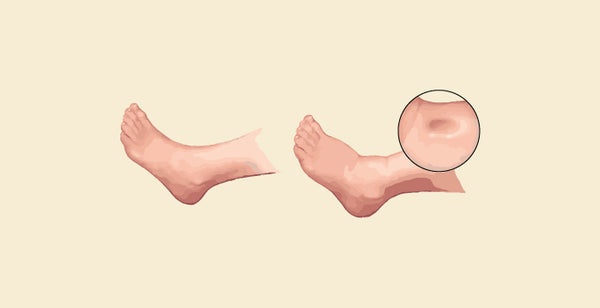Difference between Angioedema vs Edema: Angioedema and Edema are two different conditions characterised by swelling. What they differ in is their underlying causes and features. Edema can be characterised by the accumulation of excessive fluid in the tissue. Whereas Angioedema results in rapid swelling beneath the skin's surface due to allergic reactions, hereditary factors, or certain medications. Treatment approaches vary based on the root cause, ranging from managing underlying conditions for Edema to addressing allergic triggers or using medications for Angioedema relief.
Difference between Angioedema and Edema
Angioedema and Edema are different when considering the depth of the tissue involved. The table below provides the differences between Angioedema and Edema.
|
Aspect |
Angioedema |
Edema |
|
Definition |
Swelling in deeper layers of the skin |
Accumulation of fluid in interstitial spaces |
|
Location |
Face, lips, tongue, throat, genitals |
Legs, ankles, abdomen, other body parts |
|
Depth of Swelling |
Deeper layers of the skin |
Interstitial spaces in tissues |
|
Cause |
Allergic reactions, medications, genetic factors |
Heart failure, kidney disease, liver disease |
|
Symptoms |
Rapid onset, may be accompanied by itching |
Swelling, puffiness, weight gain |
|
Treatment |
Antihistamines, corticosteroids, epinephrine |
Diuretics, compression therapy, lifestyle changes |
Browse The Best Scrubs Collection!
What is Angioedema?
Angioedema is a medical condition characterised by rapid and localised swelling in deeper layers of the skin and submucosal tissues. It often affects areas such as the face, lips, tongue, throat, or genitals. Angioedema is distinct from common oEdema as it involves a more pronounced and sudden swelling, usually caused by an allergic reaction, medications, or genetic factors. In severe cases, Angioedema affecting the throat can lead to breathing difficulties, be life-threatening, and require proper medical attention. Treatment involves antihistamines, corticosteroids, or epinephrine in severe cases.
Causes of Angioedema
- Allergic Reactions: Exposure to allergens such as certain foods, medicines, insect stings, or latex can trigger Angioedema in susceptible individuals.
- Medications: Certain medicines, such as angiotensin-converting enzyme (ACE) inhibitors which are used to treat high blood pressure or heart failure have Angioedema as a side effect.
- Genetic Factors: A rare genetic disorder, Hereditary Angioedema (HAE) is caused by a deficiency of the C1 esterase inhibitor, a protein which is involved in regulating inflammation.
- Non-Allergic Triggers: Angioedema can also occur due to non-allergic factors such as physical stimuli, emotional stress, infections, or autoimmune disorders.
- Idiopathic: In some cases, the reasoning behind Angioedema may remain unknown (idiopathic Angioedema).
Symptoms of Angioedema
- Swelling: Increased selling in deep layers of the skin often affecting areas like eyelids, tongue, throat, hands, feet, or genitals.
- Pain or Discomfort: Swollen areas may feel tender or painful to the touch.
- Itching: Itching or a tingling sensation may accompany the swelling.
- Difficulty Breathing: In cases where Angioedema affects the throat or tongue, it can lead to difficulty breathing, swallowing, or speaking. Severe throat swelling can be life-threatening and requires immediate medical attention.
- Abdominal Symptoms: Angioedema can also cause swelling and discomfort in the abdomen, leading to nausea, vomiting, or diarrhoea.
What is Edema?
Edema is a medical condition which is defined as accumulation of excessive fluid in the interstitial spaces of tissues which leads to swelling of various parts of our body. Increased capillary pressure, leakage of fluid from blood vessels, reduced lymphatic drainage, or abnormalities in the body's electrolyte balance are the reasons for the fluid buildup. Treatment options depend on the underlying causes. Treatments may include medications, making prompt changes in lifestyle, compression therapy and addressing the primary medical condition.
Causes of Edema
- Failure of Heart: When the heart is unable to pump blood properly. fluids can accumulate in the body's tissues, which leads to Edema, mainly affecting the legs, ankles and abdomen.
- Kidney Disease: Improper functioning of the kidney can result in an imbalance of electrolyte and fluid retention.
- Liver Disease: Cirrhosis can cause fluid to build up in the abdomen and other parts of the body due to improper functioning of the liver.
- Venous Insufficiency: Damage to the valves may result in improper blood circulation which can lead to fluid leakage into surrounding tissues and Edema.
Symptoms of Edema
- Swelling: Puffiness or swelling around the affected area which involves the legs, ankles, arms and abdomen.
- Changes in Skin: Skin over the swollen part may appear to be discoloured, shiny or stretchy.
- Increase in Weight: Edema can cause a sudden increase in body weight because of fluid retention.
- Reduced Movements: Edmea may lead to reduced mobility of legs which indeed makes it difficult for one a move or walk properly when touched.
Shop Best Lab Coats From Here!
Similarities between Angioedema and Edema
- Swelling: Angioedema and Edema both cause swelling although the location and the depth vary. Angioedema involves swelling in deeper layers of the skin whereas Edema involves swelling due to fluid accumulation in interstitial spaces of tissue.
- Discomfort: Both cause discomfort, but vary according to their severity and location of swelling. Angioedema affects the throat. Edema affects the legs.
- May Lead to Serious Complications: The chance of this happening is less bit not no. Angioedema affects the throat which can cause difficulty breathing and if not treated can be kife tweeting. Edema also affects the lungs which again can bring with it significant health risks.
To summarise, Angioedema and Edema both involve swelling. Angioedema is characterised by swelling in deep layers of tissue and can be caused due to genetic factors, allergies, or any other underlying conditions. Treatments for both depend on the particular cause of the condition.
Order the Best Jogger Scrub From Here!
| Check out More Articles | |
| Difference Between Cartilage and Bone | |
| Difference Between Endocrine and Exocrine Glands | |
| Difference Between Cell Wall and Cell Membrane | |















